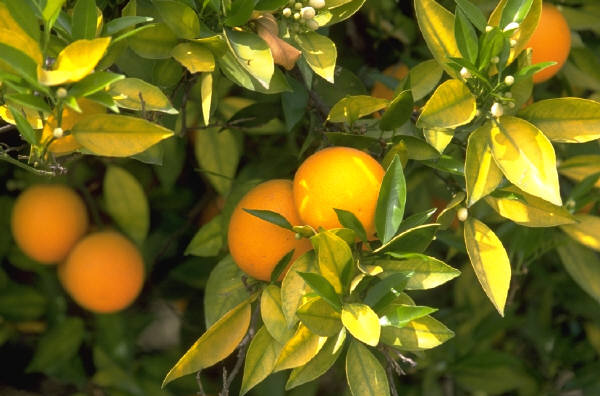14 February 2011 (Shanee/Matzah)
Day #335, 5934 AM
Tree Fruitfulness & Puberty
A Great Torah Mystery Revealed

"When you come into the land, and have planted all kinds of trees for food, then you shall count their fruit as uncircumcised. Three years it shall be as uncircumcised to you. It shall not be eaten. But in the fourth year all its fruit shall be holy, a praise to Yahweh. And in the fifth year you may eat its fruit, that it may yield to you its increase: I am Yahweh your Elohim" (Lev.19:23-25, NKJV).
The laws given by Yahweh to Israel may at first seem a litle strange to us living in the 21st century until you realise two things. First, the land of Israel was consecrated to Yahweh and is a part of His Malkut or Kingdom in the physical dimension. Second, every physical law has a spiritual counterpart, and vice versa, because the physical and the spiritual are supposed to be echad or united as one. The religion of the Bible, in both the Tanakh (Old Testament) and B'rit Chadashah Scriptures (New Testament) is neither Gnostic, Catholic, Hindu nor Buddhist because the material world is regarded as neither illusiory nor in any sense bad by Yahweh. The whole man in Hebrew thought is a man united in all his parts - spiritual, mental, psychic and physical.
The laws given regarding the harvesting of fruit trees specifically apply to a covenant-land inhabited by a covenant-people working in harmony with the Creator. The land, the people and the Creator are all echad or one. The tavnith or pattern that applies to one or the other applies to all, as of the inner and the outer man. The commandment, moreover, concerns newly planted trees. A tree, like a human, is "uncicumcised" or "unkosher" (unholy) as far as reproduction is concerned and not therefore fit for use until three years have passed. The fruit is not to be touched. In the fourth year the fruit shall likewise not be eaten but shall exclusively belong to Yahweh. Only in the fifth year may the fruit be eaten.
I have been asked to explain what this passage means and whether there is a spiritual understanding to it. There absolutely is and I wish now to share the revelation Yahweh gave this to me yesterday in preparing this answer.
Trees in Scriptures often symbolise people so on a sod or mystical level what this passage of Torah is describing is the growth of an individual into manhood (or womanhood). The fruit here represents the ability to multiply and is therefore a description of the sexual maturation process. Boys and girls become ready for sexual activity quite young but here Yahweh is saying that until a certain maturation has taken place, here represented by three to four years or cycles, they are not ready for marriage. They are metaphorically "uncircumcited" and therefore are not to be married or engage in sexual activity. In the fourth year or cycle they are ready for marriage but the first year is to be dedicated to Yahweh as a continuing celibate. They are now kosher to set-apart (holy) but the first fruits of their sexual energy is to be dedicated to Yahweh by being reprocessed and channelled into service for Him. Only in the fifth year since becoming sexually mature are they then free to marry and engage in procreation and their own family life.
Yahweh showed me that there is (as one might expect) a direct parallel with the festivals. The first three years correspond to Pesach (spiritual conception), Chag haMatzah (removing impurities/sin from your life) and Yom haBikkurim (the new birth and baptism). The fourth moed or festival is Shavu'ot or Pentecost (Betrothal Covenant, giving of Torah and baptism of the Ruach haQodesh (Holy Spirit)) is the time of committment to Yahweh as His Betrothed Bride which is spiritual marriage without sexual contact just as in the fourth fruiting year of the tree the fruit is available but belongs to Yahweh. Not until the fifth year and the fifth festival, Yom Teruah or the Day of Trumpets/Shouting, is the "tree" ready to prepare for full marriage as represented by the autumnal festivals culminating in the seventh and last festival, Sukkot or Tabernacles. This illustration of the trees is therefore a sod or mystical explanation of the tavnith of sexuality and marriage.
We know scientifically that modern boys begin the process of puberty around the age of 10 and girls around 12. Girls tend to mature faster than boys, girls achieving full puberty around 15-17 and boys about 16-18. The "fruit" of the "tree" would therefore correspond to the first time a girl ovulates and has her first menstruation (menarche) and to the time a boy makes his first sperm.

The average age of first menarche in girls is reckoned to be about 11.75 (late 11) years old or about 12. This would be her first unkosher fruit correspodning to the first year of fructition in the tree. For three years thereafter she is to be considere "uncircumcised" and therefore not to be married, taking her to the 14th year. Between the age of late 13/14 and late 14/15 she is set-apart to Yahweh as Shavu'ot (second fruits) and is not to be sexually active in marriage at this time either. This means that not until the 5th year of fruitfulness - from late 15/16 years of age onwards - may she be betrothed. How long the betrothal lasts will depend on many factors, not least of which is (outside of Theocratic Israel) the law of the land in which you live, and so could be anything from several months to three years.
The table that follows is for a young woman assuming that she reaches puberty by the age of 15. Therefore the minimum for a woman in getting married according to the Israelite tavnith or pattern would be 15-17. Of course, puberty may have started much earlier anciently so these figures only pertain to our day and age, though there may be variations between cultures. (This table does not take into account spiritual, mental and emotional maturity).
| Tree Year |
Festival |
Sexuality & Marriage |
Approx. Age |
| 1 |
Pesach (Passover) |
'Uncircumcised' (unkosher) |
Late 11-12 |
| 2 |
Matzah (Unleavened Bread) |
'Uncircumcised' (unkosher) |
Late 12-13 |
| 3 |
Yom haBikkurim (Firstfruits) |
'Uncircumcised' (unkosher) |
Late 13-14 |
| 4 |
Shavu'ot (Pentecost) |
Set-apart to YHWH (kosher) |
Late 14-15 |
| 5 |
Yom Teruah (Trumpets) |
Dedicated to husband (kosher) |
Late 15-16 |
| 6 |
Yom Kippur (Atonement) |
Betrothed to husband (kosher) |
Late 16-17 |
| 7 |
Sukkot (Tabernacles) |
Fully Married to husband (kosher) |
Late 17-18 |
The scriptural criterion determining whether a man is ready to marry or not is additionally a function of whether he can provide for his wife or not. Men tend therefore to have to be a little bit older before they are fit for marriage because of their responsibilities to provide food and shelter for their new wives. Additionally, sexual maturity in men tends to come about a year later than women.
Are there any other aspects of life that this passage about tree-fruitfulness could apply to? Most definitely and I am sure you can think of many. For example, in discipleship there are similar growth periods before believers are ready for certain kinds of service in the Body, even if they are raring to serve much as a sexually-conscious youth thinks he is ready for marriage because of the urges he feels. And this is the point: the ripe fruit does not indicate that the season for partaking has necessarily arrived. One of our weaknesses as a race (of Adam) is that we tend to get ahead of ourselves. Here, in this Torah revelation, Yahweh is telling us to pace ourselves and follow His divine tavnith (pattern) - it may not make much sense to us initially but there is great intelligence and ahavah (love) behind it always if we will but search for it.
We must allow growth processes to complete themselves before we start harvesting. And this really is the point: just because you can see a fruit doesn't mean the fruit is ready for harvesting. Having sexual impulses does not mean you are ready for sexual activity, and not giving Yahweh His portion is a demonstration that we are ruled by these impulses instead of by Him.
All new believers receive the gift of the Ruach haQodesh (Holy Spirit) as a fruit of salvation. However, the gift is applied and works in the soul in different ways depending on the spiritual season. For the newly conceived (at Pesach) this is a time of gestation only. Impurities must be kept away from this spiritual conceptus by means of a spiritual placenta which not only provides oxygen and nutritional biochemicals but also removes waste products and acts as a barrier against infection from the mother. This is the process corresponding to Chag haMatzah and is keeping the new believer away from harmful environments until he is strong enough to resist them on his own. The New Birth changes everything and the Ruach switches functions to guide and nourish the birthed believer for a new set of activities in a different sort of 'world'. And so it goes on. So the Ruach, upon reception, is not immediately to be used in the way that, for example, a mature believer might.
It is, in my view, a terrible tragedy that so many Christians bypass the Tanakh as something 'old' and no longer of much value - hence the totally inappropriate (and non-Scriptural) designation, 'Old' Testament. There is, as one writer puts it, a "marvelous Divine design running through the whole" of Old and New Testament 'parts'. In the West we unfortunately tend to view the Bible as a linear collection of texts, starting with Genesis (A) and ending with Revelation (Z). This concept is wholly erroneous, for many reasons, not least historical. You cannot lay the Bible out in a string like that for the pure and simple reason that it is a multi-layered, multi-faceted echad or unity in what might perhaps be best destribed as a living, spiritual organism. It is not just a collection of texts, verses, paragraphs, chapters and books. Since its every part is emet or truth, then both every part of the Bible, and every part that is not in the Bible which is emet, is also related, interdependent and interconnected tavnith, with the whole only being perceived by the spiritual life that comes from the revelation of the Ruach haQodesh (Holy Spirit) which itself comes from trusting in Yah'shua the Messiah (Jesus Christ) and obedience to the commandments. The Bible, and indeed all emet, has neither beginning nor ending. 'Genesis' and 'Revelation' are just finite human concepts. Thus you can start anywhere in the Bible and find the same emet, tavnith and ahavah.
The emet or truth we learn from Leviticus 19:23-25 is therefore everywhere in the Bible and indeed everywhere in Creation. The carnal eye only sees the fruit when it appears on the tree but the spiritual eye discerns the tavnith and understands the unfolding 3-1(4)-3(7) pattern. In fact we have talked about this in many places. The festivals hold vital keys which is why we must only observe the ones Yahweh commands and not add others as many Messianics do, for these destroy the tavnith and obscure the greater mind and heart of Yahweh. May Yahweh bless you with more light and truth as you dig into all His Scriptures.
 Share
Share
|


